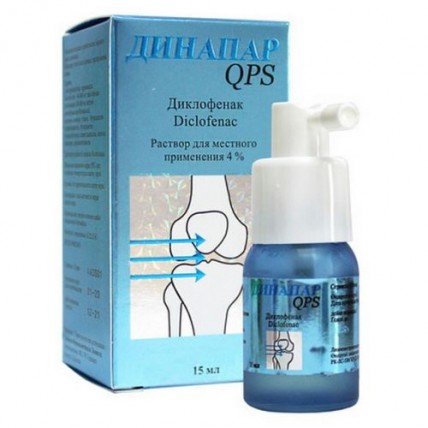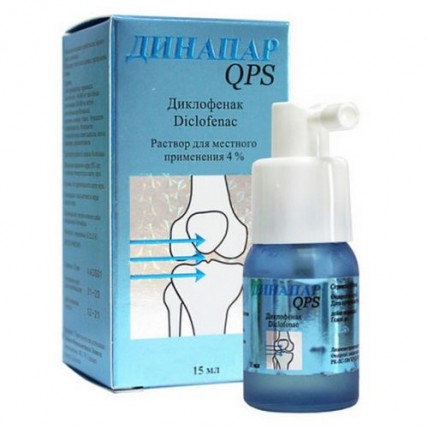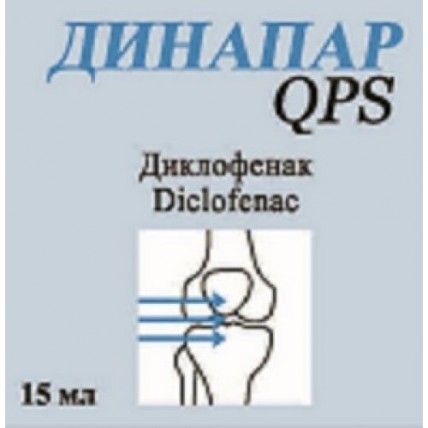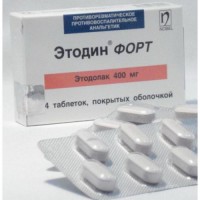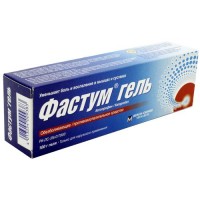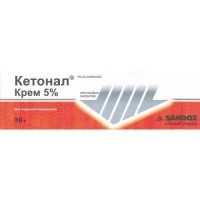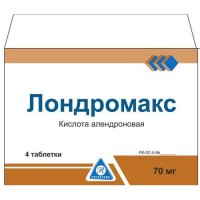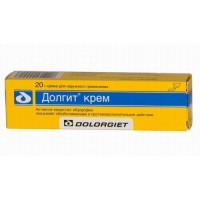Dinapar QPS 4% 15 ml solution topically applied
- $14.80
Out Of Stock
The instruction for medical use of DINAPAR QPS medicine the Trade name of DINAPAR QPS the International unlicensed name Diclofenac Dosage Form solution for topical administration, 4%, 15 ml or 30 ml Structure Active agent: Diethyl amine diclofenac Excipients: ethanol, butilgidroksianisol, ionol, oleic acid, menthol, glycerin, propylene glycol. The description Transparent solution from colourless till yellow color Pharmacotherapeutic group Drugs for treatment of diseases of a musculoskeletal system. Drugs for topical treatment of the musculoskeletal system. Non-steroidal anti-inflammatory drugs for topical administration. Diclofenac the ATX M02AA15 Code the Pharmacological Pharmacokinetics Maximum Concentration properties of diclofenac in blood plasma made 175.93± 89.49 ng/ml whereas time of achievement of the maximum concentration in blood plasma was 5.24 ± 2.59 hours. It was established that AUC0-t makes 1224.19 ± 445.69 h ng/ml whereas AUC0 inf made 1718.21 ± 740.58 h ng/ml. The pharmacodynamics Diclofenac inhibits enzyme of cyclooxygenase (SOH), an early component of a cascade of arachidonic acid that also the prostatsilina leads to reduction of formation of prostaglandins, thromboxanes. Diclofenac, active component has anti-inflammatory, anti-nociceptive and febrifugal effects. Indications of DINAPAR QPS it is shown for the symptomatic removal of slight and moderate pain and inflammation connected with: • Dorsodynia, stretching • Stupid injury of sinews, muscles and joints • The localized forms of rheumatism of soft tissues, such as subacromial bursitis, epicondylitis, acetabular bursitis, anserinovy bursitis and fibromyalgia • Arthritis of superficial joints, such as knee, brushes, etc. The route of administration and doses Dinapar QPS is intended only for external use and is not applied inside. It cannot be applied on a mucous membrane, an open wound, a cut or the injured skin. The patient should report that before use of DINAPAR QPS, the site of drawing has to be clean and dry. Before the first use of DINAPAR QPS for the first time, fill the pump, having sprayed it in air 2-3 times. On the struck area 4 piston strokes of the pump a day each 4 hours (0.4 ml are equivalent to 16 mg of diclofenac of sodium), it is necessary to put 4 times a day. The quantity of the applied courses of the piston of the pump can be higher or lower depending on the area which is subject to treatment. The maximum single dose makes 10 courses of the piston of the pump, and the maximum daily dose makes 41 courses of the piston of the pump (4 ml are equivalent to 160 mg of diclofenac of sodium), and it should not be exceeded. It should be sprayed at distance of 6-8 inches from the site of drawing. DINAPAR QPS is anhydrous solution therefore the scheme of dispersion will not resemble the scheme of spraying of aqueous solutions or spray-aerosols. The basic purpose of a system of dispersion is to provide exact dosing with each stream of the doser which delivers 0.1 ml of solution. After causing necessary amount of spray softly distribute solution a finger-tip. The patient has to receive the instruction not to mass the processed area after drawing. The patient should recommend to avoid washing and contact of the processed area with clothes or other objects within 8-10 minutes after drawing. It is recommended to use a minimal effective dose with the shortest duration. Treatment can be stopped at disappearance of symptoms (pain and/or swelling). The patient should report about need to consult with the doctor if pain and/or swelling do not pass or if they amplify within 7 days. In case of need uses more than 7 days, patients should report about need to use drug according to the recommendations of the doctor. Side effects Side effects of DINAPAR QPS were not reported. However topical administration of diclofenac can be connected with local side effects in the site of use. From skin: Local irritation, an itching, rash, eczema, an erythema (including in rare instances a bullous erythema), urticaria, contact dermatitis, contact dermatitis with vesicles, etc. Separate cases of generalized skin rash, reactions of hypersensitivity, such as Quincke's disease, anaphylactic reactions and reactions of photosensitivity, were reported at the patients using topical drugs NPVP. Contraindications • Hypersensitivity to diclofenac, acetylsalicylic acid or other non-steroidal anti-inflammatory drugs (NPVP) • The asthmatic, or the patient who has asthma attacks urticaria or acute rhinitis are called by acetylsalicylic acid or other NPVP • Children and teenagers in are younger than 14 years • The third trimester of pregnancy of CAUTION AND PRECAUTIONARY MEASURE: It is necessary to avoid contact of DINAPAR QPS with eyes or a mucous membrane and also it cannot be accepted inside. DINAPAR QPS is not recommended for use with an occlusive bandage. It was reported about reactions of photosensitivity at topical administration of diclofenac. Patsiyentov it is necessary to warn about impact of direct sunlight after use of DINAPAR QPS. Stop treatment when developing skin rash after drawing. DINAPAR QPS should be used carefully with oral NPVP as the frequency of undesirable system effects can increase. DINAPAR QPS should be used with care at patients with a peptic ulcer, a liver or renal failure, hemorrhagic diathesis or inflammatory bowel disease in the anamnesis as it was reported about the frequency of such cases at topical administration of diclofenac. Do not mix or do not put DINAPAR QPS with other strong topical means. Medicinal interactions When using according to the recommended dosage, system availability of diclofenac in DINAPAR QPS, is very low in comparison with an oral dosage form of diclofenac. Therefore, the risk of interaction of drug with other oral medicines decreases. Simultaneous use of acetylsalicylic acid or other NPVP can lead to increase in frequency of adverse reactions. Incompatibility: Do not mix and do not apply drug with other topical means or vegetable drugs. Special instructions Use for children: Use at pediatric population is not recommended as the data concerning safety and efficiency no. Use for patients of advanced age: In general, between elderly and younger patients there is no difference in efficiency or safety, but as elderly patients have higher probability of depression of function of kidneys, it is necessary to be careful when using DINAPAR QPS at elderly people, and control of function of kidneys can be useful. Use at pregnancy: Data on use of DINAPAR QPS at pregnant women are absent. The inhibition of synthesis of prostaglandins can negatively influence pregnancy and/or development of an embryo/fruit. Data of epidemiological researches confirm the increased risk of an abortion, heart failure and a gastroshizis after use of inhibitor of synthesis of prostaglandins in the early stages of pregnancy. Absolute risk of development of cardiovascular insufficiency increased with less than 1% approximately to 1.5%. The risk increases with a dose and duration of therapy. It was established that use of inhibitor of synthesis of prostaglandins increases before - both post-implantation death and mortality of an embryo/fruit. Moreover, it was reported about the increased frequency of various malformations, including cardiovascular. During the first and second trimesters of pregnancy of DINAPAR QPS it is not necessary to appoint if the advantage does not outweigh risk. If DINAPAR QPS is used by the woman trying to become pregnant or during the first and second trimesters of pregnancy, the dose has to be low, and duration of treatment of the shortest. DINAPAR QPS is contraindicated during the third trimester of pregnancy. Use during a lactation: As well as other NPVP, diclofenac gets into breast milk in small amounts. Nevertheless, at use of therapeutic doses, no effects of DINAPAR QPS on the baby are expected. Due to the lack of controlled researches at the feeding women, drug should be used during a lactation only according to the recommendation of the doctor. In such cases of DINAPAR QPS it is not necessary to apply on a breast of nursing mothers and also in other places on big sites of skin or during the long span. The feature of influence of drug on ability to run transport and potentially the DINAPAR QPS dangerous mechanisms does not influence the speed of reactions at control of motor transport. The overdose Low system availability of diclofenac in DINAPAR QPS does overdose very improbable. However it is possible to expect side effects, similar to those which are observed after overdose by diclofenac tablets if DINAPAR QPS accidentally gets inside. At the accidental ingestion resulting in considerable system side effects it is necessary to use the general therapeutic measures which are usually accepted for treatment of poisoning with non-steroidal anti-inflammatory drugs. Treatment of overdose of NPVP, generally consists of the supporting and symptomatic measures. It is necessary to consider deactivation of a stomach and use of activated carbon. It is necessary to appoint the supporting and symptomatic treatment at such complications as hypotonia, a renal failure, spasms, gastrointestinal irritation and respiratory depression, specific methods of treatment, such as artificial diuresis, dialysis or hemoperfusion probably do not help with elimination of NPVP because of their high speed of binding of protein and an extensive metabolism. The form of release and packing On 15 ml or 30 ml of drug in bottles from opaque cobalt glass (FSSA type I) with a nominal volume of filling of 15 ml or 30 ml is also sealed by means of the blooming pump of the spray covered with a ring of the pump and the drive. On 1 bottle together with the instruction for medical use of medicine in the state and Russian languages place in a cardboard box. To Store storage conditions at a temperature not above 30 °C, in the place protected from light. To store out of children's reach. To store a bottle in vertical position. 2 years not to use a period of storage after an expiration date. Prescription status According to the prescription of Proizvoditel Troykaa Pharmasyyutikals Limited, Virochannagar-382,170, Gujrat, India of Bodies No.: +9179 26856242/43/44/45. No. fax. +91 7926856246 Owners of the registration certificate of Troykaa Pharmasyyutikals Limited, Virochannagar-382,170, Gujrat, India of Bodies No.: +9179 26856242/43/44/45. No. fax. +91 7926856246 Name, the address and a contact information (phone, the fax, e-mail) of the organization in the territory of the Republic of Kazakhstan, the accepting claim (offer) on quality of medicines from consumers and responsible for post-registration observation of safety of medicine: Aldimed LLP Republic of Kazakhstan, 050051, Almaty Residential district Samal-1, House 1 Ph. + 7 727 2632734
To develop
To develop
